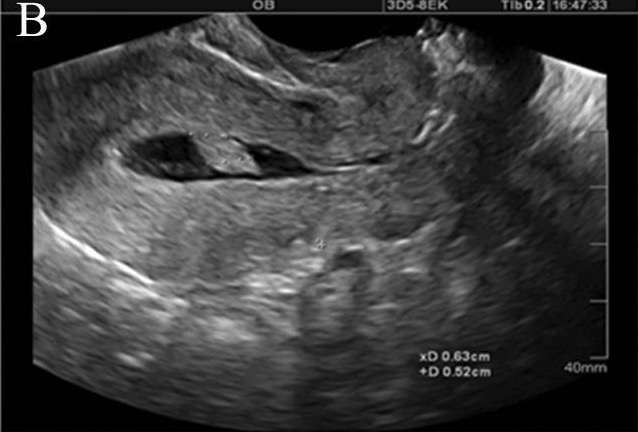Playlist
Show Playlist
Hide Playlist
AUB: Diagnostic Evaluation and Case Study
-
Slides AbnormalUterineBleeding ReproductiveEndocrinology.pdf
-
Download Lecture Overview
00:00 Let's now talk about the diagnostic evaluation of abnormal uterine bleeding. First, you want to ask them what the age of menarche was and if they’ve already had menopause when that was. 00:12 Again, the average age for menarche is 12 while it’s 51.4 for menopause. Then you want to ask them their menstrual bleeding patterns. Do they have oligomenorrhea, polymenorrhea, amenorrhea? You want to make sure that’s clearly documented in your medical record. Then you want to ask them about the severity of bleeding. Do they pass clots? Do they ruin their night gown at night? Do they have to change their pants at work, which could be very embarassing and very distressing for many women? Do they have pain with their periods? This is sometimes called dysmenorrhea. 00:46 You want to ask about the character, the severity, and then what they do at home to treat the pain. Then you want to ask them about medical conditions. Do they have hypothyroidism? Are they on any medications that could thin their blood? Then you want to ask about surgical history. 01:03 Recall you want to ask if they’ve had any bleeding after a surgery or postoperatively. Ask them about any medications they could be using. Sometimes patients are treating themselves with things that can actually increase bleeding such as certain non-FDA approved medicinals and supplements. 01:22 Then you want to ask them if they have any signs and symptoms of a possible hemostatic disorder such as Von Willebrand disease. Then on physical exam, you should do a detailed general physical exam but especially you should do a detailed gynecologic exam. First, look externally to see if there are any lesions on the vulva, then a speculum exam with a Pap smear needs to be done if it is required and she is due for her Pap smear. We talked about Pap smears in another lecture. 01:51 Then a bimanual exam needs to occur so that you can feel the cervix, make sure that it feels normal, It should feel like the tip of your nose. Then you should also do a bimanual to see how large the uterus is and usually we express that in terms of weeks. Does she have a 20-week size uterus that could be an indication that she has fibroids or adenomyosis or a combinaton. So in terms of laboratory tests, what we want to do is a pregnancy test first and foremost to rule it out. 02:23 Sometimes we need to do blood and urine depending on the clinical scenario. A CBC or a complete blood count is important to make sure the patient does not already have anemia. Then, based on the history, we should do targeted screening for bleeding disorders only when indicated. A TSH should also be checked to make sure the patient is not hypothyroid. 02:45 Sexually transmitted infections such as chlamydia can also lead to abnormal uterine bleeding or AUB. 02:53 In terms of the diagnostic test, we reviewed this a little bit before, but again, a saline infusion sonohistorography is very important and it can show us a polyp or a fibroid or any other lesion that could be causing the bleeding. A transvaginal ultrasound is also helpful as we can actually measure the size of the uterus. An MRI is sometimes helpful especially when you have a large uterus that can be either caused by leiomyomas or adenomyosis. And lastly, hysteroscopy, where we insert a small camera through the vagina into the cervix and into the uterus to actually visualize any pathology that could be there. The other things that we can do in the office, especially in the perimenopausal or postmenopausal women over 45, is to do an endometrial biopsy. While that sounds really painful, it’s just a straw that provides gentle suction to allow us to take some of the endometrium to sample it. Usually this is done in several passes to make sure that we have enough tissue to send to pathology. Again, in the office, we can do a hysteroscopy-directed endometrial sampling but this is usually not done because the Pipelle is usually sufficient. Pipelle is another Endometrial pipelle sampling is another name for endometrial biopsy, which may occur in the diagnostic evaluation of AUB. 04:16 term for endometrial biopsy. So, AUB management really depends on the etiology. First, you have to determine what type of AUB you think the patient has and then evaluate her with a good general physical exam, a GYN exam after obtaining a very thorough history, then you can manage based on the etiology. So, if a patient comes in to the emergency room with acute bleeding, this is important to remember. You can stop acute heavy bleeding with 25 mg of conjugated equine IV estrogen and this would help and sometimes these patients are taken to the operating room for dilation and curettage to actually take some of these endometrium away so that the bleeding is less. This is normally only given to a young, healthy patient who has no other medical comorbidities, which should be a contraindication to estrogen. Let’s remember some things now about AUB. Don’t forget to check for foreign bodies in young girls. The most common foreign body that you will recover is toilet tissue. Fibroids are very common, especially in women of African descent. So you might get a case with a woman who is of African or Carribean or African-American descent, don’t forget to remember fibroids. Thyroid abnormalities are also a possibility with severe AUB and a TSH should always be checked in these patients. Also, in the young girls platelet dysfunction is the most common coagulopathy and don’t forget to ask about a history of bleeding after surgery or with brushing your teeth, or after cutting yourself. These things will be helpful to delineate this diagnosis. Let’s now review some cases of AUB. Here we have a 25-year-old G0 with a BMI of 45 who presents to the emergency room with an extremely heavy period. Her last period was 6 months ago. That should be a red flag. You should’ve had a period every month. Her exam is notable for hirsutism. She has a high BMI and hirsutism. What does this sound like? What’s your differential diagnosis? PCOS should be your most likely. Given the fact that it’s very common, she has an elevated BMI, most PCOS patients are obese, and they also have to have some type of hyperandrogenemia, which leads to hirsutism oftentimes but you should not forget to rule out pregnancy, fibroids, infection, coagulopathy, and thyroid abnormalities especially in obese patient who may have thyroid abnormalities. Let’s now review another case of AUB. Here we have a 65-year-old woman who presents to you. She is a G2-P1-0-1-1 who underwent menopause at 52 years of age, just a year after the normal average. She now presents with onset of vaginal bleeding. Her only medications include calcium and vitamin D, so she is pretty healthy. 07:18 What’s in your differential diagnosis? I’ll wait while you think about that. So, the first thing that you should think about in your differential should be atrophic bleeding. So, she can have a little bleeding from her vagina due to atrophy, which means that after estrogen stops being made, the vagina can become small or atrophic and can sometimes bleed with penetration or just by itself. Also the line of the endometrium can also bleed because it’s thin and sometimes that can cause spontaneous bleeding. These patients are also at risk for endometrial cancer. While this patient seems normal and healthy, the very obese patient has unopposed estrogen because of peripheral aromatization that occurs in the adipocytes. That estrogen does affect the line of the endometrium and that can lead to endometrial cancer. Polycystic ovarian syndrome patients during their reproductive years can also be at risk for endometrial cancer in their postmenopausal years. Also, these patients are older and they can be on blood thinners for cardiovascular reasons. 08:33 Thank you for listening and I hope you do well on your exam.
About the Lecture
The lecture AUB: Diagnostic Evaluation and Case Study by Lynae Brayboy, MD is from the course Reproductive Endocrinology. It contains the following chapters:
- Diagnostic Evaluation of AUB
- AUB: Case Study
Included Quiz Questions
Which of the following is LEAST appropriate for diagnosing abnormal uterine bleeding?
- CT with contrast
- Saline infusion sonohysterography
- Transvaginal ultrasonography
- Magnetic resonance imaging
- Hysteroscopy
A 35-year-old woman is diagnosed with PCOS and has abnormal uterine bleeding. She refuses to undergo treatment. At the age of 50, she develops endometrial cancer. What is the most likely cause of this?
- Unopposed estrogen
- Unopposed progesterone
- Unopposed estrogen and progesterone
- Unopposed thyroid hormones
- Unopposed cortisoll
A 25-year-old woman is diagnosed with PCOS and has abnormal uterine bleeding. She refuses to undergo treatment. What is the patient at risk for in the future?
- Endometrial cancer
- Atrophic endometrium
- Premature menopause
- Endometriosis
- Serous cystadenomas of the ovary
Which of the following is a good method to stop acute menstrual bleeding?
- 25 mg of conjugated equine IV estrogen
- Uterine artery embolus
- Progesterone only pills
- Combined oral contraceptive pills
- Hysterectomy
Which of the following is the most common cause of coagulopathy in teenagers with abnormal uterine bleeding?
- Platelet dysfunction
- Hemophilia A
- Hemophilia B
- Iatrogenic
- Drug induced
Customer reviews
5,0 of 5 stars
| 5 Stars |
|
1 |
| 4 Stars |
|
0 |
| 3 Stars |
|
0 |
| 2 Stars |
|
0 |
| 1 Star |
|
0 |
Tis lecture and all the subsequent lectures on abnormal uterine bleeding was very helpful. At first had difficulty understanding the topic, then i came across the videos. They have helped me better understand and feel more confident in answering questions concerning this topic.




